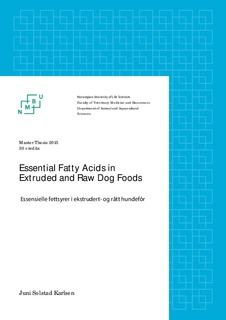| dc.description.abstract | This thesis is divided into two sections: section 1 explaining the theory about fat and fatty acids functions, health effects and sources, section 2 includes a study of commercial extruded and raw dog foods.
Fat is the most energy dens nutrient and functions as energy, structural components in cell membranes, source of essential fatty acids (EFA), precursor to biological active substrates and carrier of fat-soluble vitamins. EFA cannot be synthesized by the animal, and needs to be added in the feed. EFA includes n6 fatty acids: linolenic acid (LA) and arachidonic acid (AA), and n3 fatty acids: α-linolenic acid (ALA), EPA and DHA. LA and ALA being precursors for AA, and EPA and DHA, respectively. The n6 and n3 families compete for the same enzymes for elongation and desaturation in the body. The n6 fatty acids, especially AA and its eicosanoids, have an inflammatory effect and induces responses to infections in the body. Whereas long chain n3 fatty acids and its eicosanoids are less biologically active and have anti-inflammatory responses. Therefore, the dietary concentrations of n6 and n3 fatty and dietary n6:n3 ratios can give different biologically responses through its eicosanoids. Vegetable oils are good sources for LA and ALA, marine sources are the only source for EPA and DHA, and AA is only found in animal sources. Recommended supply for LA to adult dogs are established, while supplementation for ALA, EPA and DHA is recommended by National Research Council (NRC), but not by the Association of American Feed Control Officials (AFFCO) or European Pet Food Industry Federation (FEDIAF). The two latter organisation have recommendations, besides LA, for puppies only. The scientific knowledge on EFA supply in dog foods is therefore not complete.
The present study was conducted to obtain information about the content of fat and fatty acid composition in 18 commercial dog foods (11 extruded and 7 raw foods) in the Norwegian market, by comparing low price (LP, n=4) and high price (HP, n=7) dry foods, and extruded and RWs (n=7). The extruded foods had substantially higher average concentrations of carbohydrates (49.6-56.0 %) on DM basis than the RW diets (9.7 %) and conversely, fat levels (42.4 %) in the RW group on DM basis, were significantly higher than the dry foods (11.9-15.8 %). The content of saturated fatty acid (SFA) was significantly higher in the RW group (p<0.0001), due to high amounts of beef tallow compared to the dry foods. All diets were above or met the NRC’s recommendation of LA (0.67 g/MJ), except for two diets in the RW group (0.35 and 0.33 g/MJ). All but one diet (0.01 g/MJ) met the recommendation level for ALA of 0.03 g/MJ. Several diets had levels high above recommendation, especially diets in the RW group (average of 0.2 g/MJ). The AA was present in all diets and varied from 0.02 in the LP group, 0.03 in the HP group to 0.06 g/MJ in the RW group. However, there were only significant difference (p<0.005) between the dry foods and the RWs. EPA and DHA concentrations varied greatly between diets (0.0-0.56 g/MJ), but was not significantly different between groups. One diet differed substantially from the others with the highest concentration of EPA and DHA of 0.56 g/MJ, this was approximately 18 times higher than the recommendation (0.03 g/MJ). Another diet deviated by not containing EPA or DHA, however, this diet contained the highest amounts of ALA (2.03 g/MJ) among the dry foods. Dietary n6:n3 ratio was significantly higher (p<0.02) for the LP group (8.3:1), compared to the HP (4.7:1) and RW (4.0:1) group. The ratio was especially low in one of the dry foods (1.2:1).
To conclude, the EFA and dietary n6:n3 ratios in individual diets varied substantially, irrespective of diet type, extruded or raw. The EFA content differed between the low price and high price group, but not significantly. Indicating that great individual differences between diets gave high variations within each group. Raw diets contained a higher content of fat (% DM) than the extruded diets, but had similar levels of EFA. AA was the only single fatty acid significantly higher in the raw foods, compared to the extruded diets. | nb_NO |
